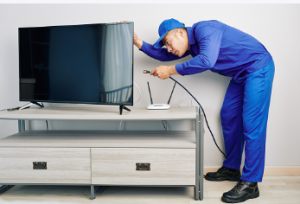How to Go About TV Antenna Installation
When installing a TV antenna, there are a few things to consider. These include location, size, quality, and cost. These four factors will help you choose the best antenna for your home. Once you’ve decided on an antenna, you can begin the installation process. The next step is to connect the antenna to your television. For this, you’ll need a high-quality coaxial cable. This type of cable has a centre wire that carries the signal and is surrounded by a plastic insulator. It also has an outer braid or sheath that shields the signal from external interference.
 Size
Size
When installing a TV antenna, size is an important consideration. There are a variety of sizes to choose from, and you will want to make sure you know which is right for your property. The size of your antenna can affect all the TVs in your house. Small antennas are compact, while larger antennas are often mounted on the roof. The larger antennas have a larger surface area and will provide better reception.
It would help if you also determined the strength of the antenna’s signal. For example, the signal quality will improve if your antenna is installed at a higher height. You will also need to ensure that your home has a clear line of sight for the antenna. The type of terrain will also affect your signal quality. For example, your TV antenna installation Adelaide may have trouble receiving signals if you live in a hilly area. If this is the case, you should purchase an amplifier for the antenna.
Quality
When choosing an antenna installer, make sure to consider the quality of the job. The technician will ensure the antenna is mounted securely and all cables are run correctly. The technician should also test the signal and evaluate how many channels you receive. They should also teach you how to use the antenna control system. It would help if you also looked for experience with installation.
An antenna’s performance can be negatively affected by interference from external sources. This interference usually occurs when two or more transmitters broadcast simultaneously. An expert can pinpoint the source of the interference and work on fixing the problem.
Cost
If you’re looking to cut your cable and satellite TV bill in half, you might be interested in a TV antenna installation Adelaide. A new antenna will provide you with free, high-definition broadcasts from your local stations and can save you $150 or more per month on your cable or satellite bill. An antenna can also give you local news broadcasts, which your cable company and satellite provider don’t usually offer. A TV antenna can also improve the quality of your TV picture and is a cheaper alternative to a high-definition receiver.
An experienced installer will also ensure the antennas they install meet D.B.A. standards, so you won’t have to worry about them disintegrating in high winds. However, you should also be aware that cheap installers might not be insured, paying taxes, or operating a solvent business. Furthermore, they may not be available when you need them.
Coaxial cable
Coaxial cable connects a TV antenna to an external source, such as a TV tower or a digital cable line. It also lets users stream web content to their TV. The cable is often run through walls, and it can connect TV antennas and cable connections located in different rooms. In addition, it can be used to connect the main cable line for a neighbourhood to individual homes.
When installing a TV antenna, it is important to remember that the connection between it and the television is just as important as the antenna itself. Therefore, it is important to use a good quality coaxial cable, or coax, to transmit the signal to the TV. Coaxial cable has a centre wire that carries the signal and is surrounded by an insulator made of plastic. In addition to insulating the centre wire, it also has a protective outer sheath to protect it from the elements and prevent it from being damaged by noise.
Guy wires
If the antenna is attached to a building, use galvanized guy wires. This type of wire is ideal for antenna masts over 20 feet and is the best choice for areas with high winds. Galvanized guy wires will also help avoid signal degradation if the antenna sways. Guy wires of this type are generally six strands long and are available in 100-foot lengths.